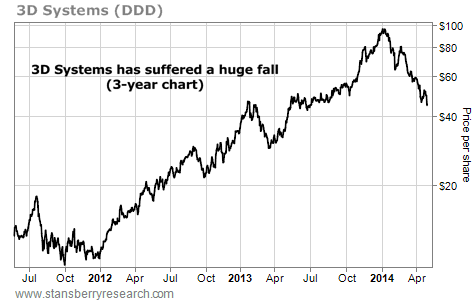| Home | About Us | Resources | Archive | Free Reports | Market Window |
The Massive New Oil Discovery You Didn't Hear AboutBy
Thursday, May 1, 2014
The Deepwater Horizon was an epic disaster.
The $500 million floating drill rig exploded in April 2010. Eleven people died. The rig burned and eventually sank to the bottom of the Gulf of Mexico. Within a few days, an oil slick covered more than 500 square miles. Major oil firm BP – which operated the Macondo deep-sea oilfield being drilled – and its partners face roughly $20 billion in liability for the accident.
But how much oil had been spilled?
Immediately following the accident, BP claimed that the Macondo wellhead was discharging 1,000 barrels of oil per day. The first U.S. government estimate from oceanographers was five times this much oil: 5,000 barrels per day.
Within two weeks of Deepwater Horizon's fire, the U.S. Geological Service said 12,000 barrels a day might be coming out. It later revised this estimate upwards, to an average of 19,000 barrels per day, with a peak around 25,000 barrels.
Meanwhile BP tried to capture the escaping oil. It sent a ship with 15,000-barrels-a-day uptake capacity. It didn't so much as dent the problem. So then, BP sent a special oil-burning barge. This could handle another 10,000 barrels per day. But even with 25,000 barrels a day of combined capture and burn facilities, the oil kept flowing.
Looking through an underwater camera attached to the top of a remote-control submarine stationed just outside the wellhead, a scientist from the Woods Hole oceanographic research institute estimated the Macondo was pouring out 60,000 barrels per day.
After the well was finally capped, looking at the pressure of the oil still trying to get out, this figure remains the official estimate: more than 60 times the flow BP initially claimed.
To put this in perspective... only one in 1,000 onshore wells can produce 10,000 barrels per day. Macondo beats that by six times.
This may have been one of the most important stories of the past decade... but the accident obscured it. While the rest of the world was busy suing BP and writing about environmental devastation... we couldn't stop thinking about the Macondo.
And we weren't alone...
Over the last few years, the industry has been quietly investing huge amounts of money into the Gulf. The numbers you'll see when talking about acreage, drilling depths, and potential reserves will seem outrageous. But we assure you... they are all very real. We're already seeing the big oil companies lay down huge investments for operating leases in the Gulf.
For example, oil and gas giant Anadarko owns more than 2 million acres. In December last year, British oil major BP announced a significant discovery at the Gila prospect in depths at around 30,000 feet, about 300 miles southwest of New Orleans. Giants like Exxon are there. As are U.S. producer Apache, Norway's Statoil, and Australia-based multinational minerals and petroleum firm BHP Billiton, to name a few.
Around the world, offshore exploration can be full of unnecessary drama. Some countries make you hire inexperienced locals... or bribe government officials... or navigate through last-minute tax and regulation changes. Doing business in a predictable legal system, right next to the world's most extensive energy infrastructure, makes the Gulf especially attractive to oil companies.
Lifting costs are also relatively cheap in the Gulf... you're never more than 200 miles away from the U.S.'s massive refining and transportation infrastructure... and best of all, you don't have to bribe anybody to bid for the land. As Statoil head of North American exploration Jez Averty explains: "A barrel of discovered oil in the Gulf of Mexico is difficult to beat for value anywhere else [in the world]."
Here's a prediction many people will scoff at:
The reservoirs being discovered right now in the deepwater Gulf of Mexico will position the United States as the world's largest producer of energy.
The energy boom we're enjoying today – brought on by the discovery of onshore shale oil – will be expanded by a scale unimaginable to most investors by the offshore assets being pioneered right now.
Meanwhile, the best news for investors is that the oil industry's success with onshore shale has temporarily overshadowed all of these offshore discoveries.
There's a widespread (and false) belief that the expense of offshore production means that these oil resources won't be produced as long as the shale boom remains. That's wrong... But as long as that view remains dominant, we have an excellent opportunity to buy up the best offshore-production assets for a fraction of their cost to build.
And we think that's one of the best ways to play this new oil boom.
I'm talking about the companies that provide the "picks and shovels" for the producers investing heavily in the Gulf of Mexico. (You can learn more about "picks and shovels" investing right here.)
Deepwater rig contractors like Diamond Offshore (DO), Ensco (ESV) and Transocean (RIG) provide the drilling rigs producers will use to extract oil from these massive hidden reserves in the Gulf. They stand to do billions of dollars of drilling business over the coming years.
And over the past six months, many of these companies have gone on sale...
In the table below, you can see just how cheap the top three industry leaders have become:
All three are selling well below the S&P 500's average price-to-book of 2.75. And Ensco and Transocean are actually selling for less than the net value of their assets...
The Gulf will be one of the world's energy hotspots for years to come. And producers won't be able to extract its massive hidden reserves without state-of-the-art deepwater rigs... the type of rigs that these companies provide.
Right now, the market is handing us an opportunity to buy these companies at bargain-basement prices. It's a great way to invest in the massive land rush that's quietly happening right now in the Gulf of Mexico.
Further Reading:
In the energy sector, "picks and shovels" are the companies that supply equipment, drill wells, and build infrastructure. On Wall Street, this area of the market is called "oil services." And these companies are enjoying a big uptrend. Learn an easy way to trade them right here.
In a candid interview with Porter on Stansberry Radio, we learned that T. Boone Pickens is also optimistic about the future of "ultra-deepwater" wells in the Gulf of Mexico. He says the cost will be high, but "a lot of money will be made from it." To learn more about the future of oil, listen to the interview (or download the transcript) right here.
Market NotesA LESSON ON POPULARITY AND DANGER Our bearish note on 3D printing continues to be a heck of call...
Back in January, we ran a warning on the market's top 3D-printing stock, 3D Systems (DDD). 3D printing is the printing of solid objects instead of conventional "on paper" printing. The industry uses computers and special materials to "print" things like tools, guns, and toys. It has become one of the biggest tech stories in the world.
As we noted, big stories usually produce big stock gains... and then get far too popular with the investment public. We mentioned 3D Systems was too popular... and due for a big drop.
At the time of our original note, 3D Systems traded for $76. It has since fallen by nearly $30 per share (a 39%) drop. It's another reminder of the investment truism: The more popular an asset gets, the more dangerous it gets.
 |
Recent Articles
|



